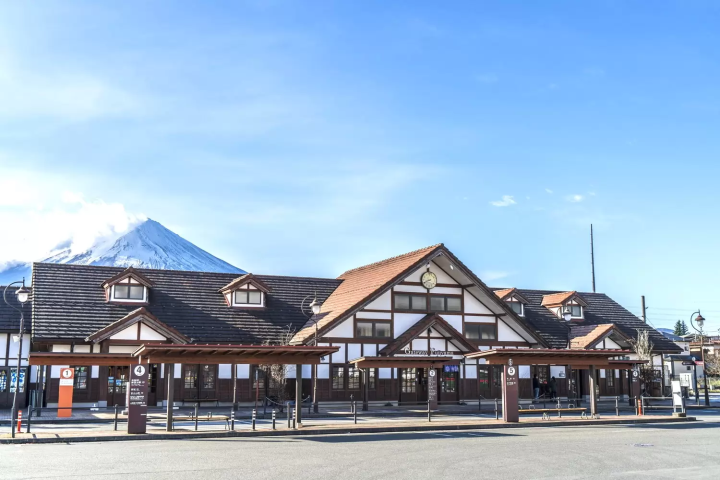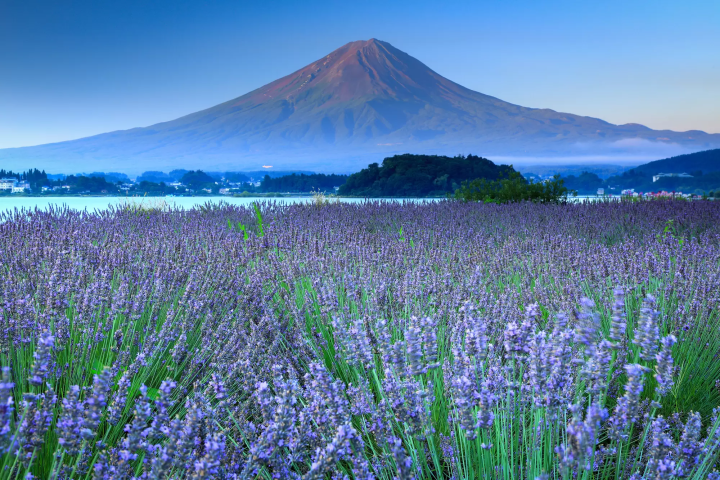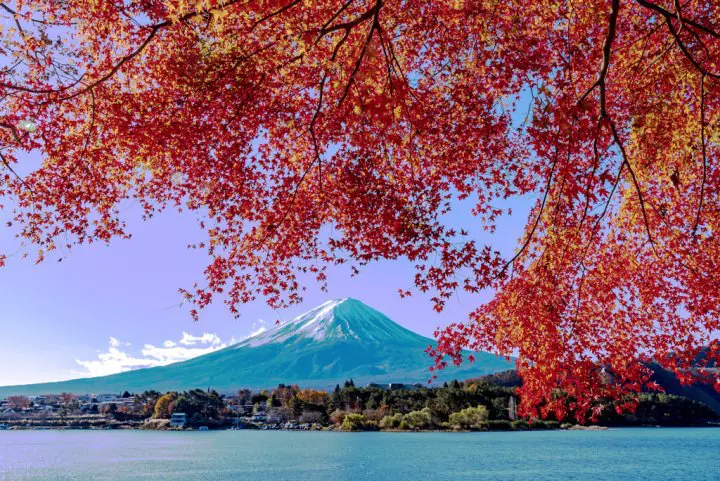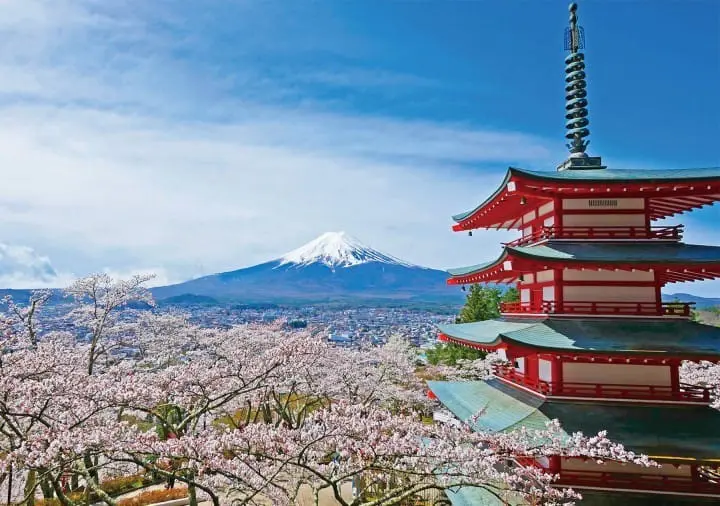Weather Near Mount Fuji Year Round: Kawaguchiko Travel Tips

Kawaguchiko City, home to Lake Kawaguchi, is one of the best places to enjoy views of Mount Fuji. We introduce the year-round weather in Kawaguchiko, with tips on what to wear each season and how to enjoy viewing cherry blossoms and autumn foliage with Mount Fuji.
Weather near Mt. Fuji and Lake Kawaguchiko
Kawaguchiko and Mt. Fuji Area Weather Characteristics
Kawaguchiko Weather by Seasons
Spring Weather in Kawaguchiko
Summer Weather in Kawaguchiko
Autumn Weather in Kawaguchiko
Winter Weather in Kawaguchiko
Cherry Blossoms and Autumn Leaves by Mount Fuji: The Best Time to See Them
Read also
Kawaguchiko and Mt. Fuji Area Weather Characteristics

Photo by Pixta
The Fuji Five Lakes region, including the city of Kawaguchiko and Lake Kawaguchi, is situated at an elevation of about 800 to 900 meters, with an average annual temperature of only 11°C. This is quite cool and comfortable compared to Tokyo's average temperature of 16.4°C.
Kawaguchiko experiences a short, warm, and humid summer, often characterized by cloudy days and sudden rainfall; while the winters are cold with a likelihood of snow, the weather is usually clearer.
The temperature variation in Kawaguchiko throughout the year ranges from -7°C to 26°C, rarely dropping below -11°C or rising above 29°C, making it a comfortable and suitable climate for travel.
However, due to its proximity to the mountains, the weather can change rapidly within a single day, leading to significant temperature differences. In addition to preparing clothes suitable for the season, it is also advisable to bring extra layers like jackets or hats.
The Best Time to Visit Kawaguchiko and the Mt. Fuji area
From a temperature perspective, the climate in Kawaguchiko is warm and suitable for outdoor activities from late July to early September.
However, due to the likelihood of clouds and rain caused by upward air currents, it can be challenging to see Mount Fuji.
Although winter is cold, clear weather often allows for stunning views of the snow-capped Mount Fuji, which is one of the region's greatest attractions.
Weather in Kawaguchiko by Seasons
Below we introduce the weather features and travel tips for each season in Kawaguchiko and the Mt. Fuji area.
Spring in Kawaguchiko (March to May)

Photo by Pixta
In March, Kawaguchiko still offers views of snow-covered Mount Fuji, with an average temperature around 2°C and lows potentially dropping to -2°C, so it’s essential to be prepared for the cold.
Even in April, the average low temperature is only 3°C, which remains quite chilly, making it advisable to wear a down coat or a thick jacket.
By mid-April, after Japan's Golden Week, the maximum temperature begins to reach 18°C, allowing for comfortable sightseeing in the Fuji Five Lakes area while enjoying the stunning views of Mount Fuji amidst blooming flowers like cherry blossoms, tulips, and phlox.
However, it's important to note that springtime presents significant temperature fluctuations between day and night; evening temperatures can still drop below 10°C, so carrying a light jacket is recommended.
Summer in Kawaguchiko (June to August)

Photo by Pixta
In the summer, the average daily maximum temperature in Kawaguchiko exceeds 21°C, particularly in July and August, which are the hottest months of the year, with average highs reaching 26°C and lows around 17°C.
This period is characterized by fluctuating weather and is also the rainiest time of the year, so it’s advisable to carry rain gear just in case.
In June, the weather is typically not too hot, with average temperatures around 18°C, making it a great time to enjoy viewing lavender and hydrangeas. However, sudden rain showers can occur, and temperatures may drop quickly afterward, so bringing rain gear and a light jacket is recommended.
July and August are peak seasons for lakeside activities like camping, and firework festivals are held at various lakes, creating a vibrant atmosphere. Average maximum temperatures can reach about 28°C, making short-sleeved shirts, hats, and umbrellas for sun protection the best choice.
Read also
Autumn in Kawaguchiko (September to November)

Photo by Pixta
In early autumn, the average temperature in Kawaguchiko ranges from 14°C to 22°C, creating a pleasant climate that is perfect for visiting art museums around the lake and enjoying the beauty of autumn.
However, September's rainfall is comparable to that of the rainy season, making rain gear essential. Toward the end of September, temperatures begin to drop, so it is advisable to wear long pants and long-sleeved clothing; you should also bring along a thicker jacket.
After October, Mount Fuji may experience its first snow, and temperatures will start to decrease significantly, with average lows dropping below 8°C.
During the autumn foliage season in November, the average high temperature may only reach 11°C, while nighttime temperatures can dip below 3°C. It is recommended to wear sweaters and coats when enjoying the fall colors, especially for those who want to appreciate the night views—keeping warm should be a top priority!
Read also
Winter in Kawaguchiko (December to February)

In winter, the temperature in the Lake Kawaguchi area can drop below zero, with maximum temperatures only reaching about 5°C. Snowfall is common during this period, and the ground may become icy. In addition to carrying an umbrella, it's essential to wear non-slip shoes or boots!
However, the air is clear in winter, often resulting in cloudless days, and under the sun, it feels less cold while offering clear views of Mount Fuji.
When visiting Kawaguchiko during winter, it’s crucial to take appropriate cold weather precautions. Thermal underwear, sweaters, and down jackets are basics, and don't forget to bring scarves, earmuffs, gloves, hats, and hand warmers.
Cherry Blossoms and Autumn Foliage by Mount Fuji: The Best Time to See Them
Japan's distinct seasons offer a variety of breathtaking natural scenery, especially during the annual cherry blossom and autumn foliage seasons.
Kawaguchiko and Lake Kawaguchi allow visitors to enjoy views of both Mount Fuji and beautiful seasonal scenery, making it a beloved destination. Below, we’ll provide information on when to book your tickets to catch the most beautiful sights!
Cherry Blossoms and Mount Fuji at Lake Kawaguchiko

The best time to enjoy cherry blossoms in the Lake Kawaguchiko area is around mid-April to late April each year.
We particularly recommend enjoying the view from the northern shore of Lake Kawaguchi, where you can see both Mount Fuji and the lake framed together, surrounded by beautiful pink and white cherry blossoms.
You can stroll along the lakeside pathway while admiring the flowers. During the cherry blossom season, a cherry blossom festival is held, featuring food and merchandise stalls during the day, and in the evening, you can enjoy the magical scenery of illuminated night blossoms!
Read also
Autumn Leaves and Mount Fuji at Lake Kawaguchiko

Photo by Pixta
Around Lake Kawaguchiko, there are approximately 400 to 500 maple trees, with the peak foliage season occurring from late October to late November each year. The stunning scenery reflects beautifully on the surface of the lake, and various activities are held in the surrounding area.
One of the most popular spots, the Maple Corridor, features a light show during the annual Fuji Kawaguchiko Lake Maple Festival. The sight of Mount Fuji appearing amidst the vibrant red leaves illuminated by the lights is truly unforgettable.
Read also
Weather Visibility of Mount Fuji at Lake Kawaguchi

Photo by Pixta
Winter is considered the best season to view Mount Fuji due to the stable weather conditions, offering the highest chances of seeing the mountain throughout the year. The snow cover on Mount Fuji's peak adds to the scenery's beauty.
Particularly from October to February, it’s common to witness the breathtaking Diamond Fuji, where the sun aligns perfectly with the mountain top, and the Pearl Fuji, enhanced by the full moon. These dreamlike vistas encourage visitors and photographers to wait for those perfect moments!
Additionally, the time before 8:00 AM each day is the best time to see Mount Fuji. Especially in the early morning, when there are no boats on the lake, it becomes much easier to capture the stunning reflection known as "Inversed Fuji."
Read also
Mt. Fuji Travel Tips from MATCHA
The weather forecast for Kawaguchiko introduced above is based on the average temperatures of past years, but weather can be unpredictable. It's important to keep an eye on the latest forecasts for Kawaguchiko.
Make sure to check the weather outlook for the next 15 to 30 days and prepare accordingly. Having a flexible backup plan can help ensure that your trip remains enjoyable, regardless of the weather conditions.









































![[Close to Chubu Centrair International Airport] Tokoname's beloved "town milk"](https://resources.matcha-jp.com/resize/720x2000/2026/01/08-255159.webp)



![[2026] Top 5 Strawberry Picking Spots in Tokushima, Naruto| Farms and Access Guide for January to May](https://resources.matcha-jp.com/resize/720x2000/2025/03/06-227165.webp)